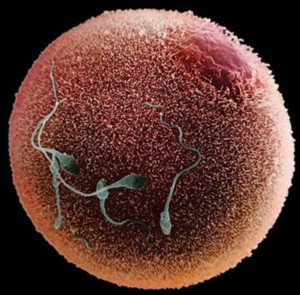Replication
The DNA molecular structure resembles a zip fastener, where each tooth can be any of four molecular bases. The bases G-C and A-T are each small organic molecules that at one point are covalently bound to a triphosphate (containing three phosphorous atoms) and a sugar group that binds them in a ribbon. At their free end Guanine is attracted to Cytosine, with triple hydrogen bonds, and Adenine is attracted to Thymine, with double hydrogen bonds.
In the following notation: black = Carbon; blue = Nitrogen; red = Oxygen; white = Hydrogen. Bars joining them indicate a covalent bond, an electron shared between the atoms. A double bar indicates two shared electrons.
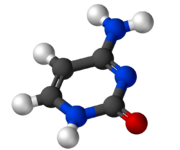 Cytosine (C4H5N3O) has a shape that attracts (fits)
Cytosine (C4H5N3O) has a shape that attracts (fits) 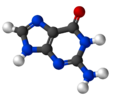 Guanine (C5H5N5O)
Guanine (C5H5N5O)
but not  Thymine (C5H6N2O2) or
Thymine (C5H6N2O2) or 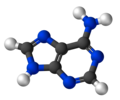 Adenine (C5H5N5), that attract (fit) each other.
Adenine (C5H5N5), that attract (fit) each other.
Each of these bases is bound to a ribbon of sugar molecules and at its other end lightly bonds to a matching base on the other half of the 'zipper' such that when it is 'unzipped' each attracts its opposite number (like magnets attracting the opposite pole) thus recreating a new matching half in the same sequence.
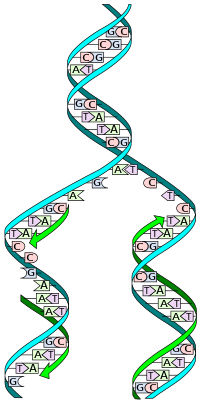
DNA replication.
This unzipping and reforming is called self-replication. It is going on continuously in all living things as new cells are created to replace those that die. In an adult human around three quarters of a million of our cells divide every second. This cell division is the process we call organic life and may continue (usually briefly) after we are legally (brain) dead.
Other chemical mechanisms within the cell translate the genetic information stored in the DNA sequence to manufacture the proteins from which new cells are built and differentiate themselves, organising to become our various organs and to thus arrange themselves to form a human; and not a gorilla or a crocodile or a kola or a rose or a cabbage. The human genome project had now identified 32,185 human genes.
Accurate reproduction is very important to the viability of an organism. Just as: 'WOLF' does not have the same meaning as 'FOWL' the location and order of sequence G-A-T-C within a particular DNA string (chromosome) will result in a different outcome to the sequence C-A-G-T . And this difference will influence cell structure and purpose: 'The wolf eats the fowl' has a totally different meaning to: 'The fowl eats the wolf'.
This method of storing and reproducing instructions and data is twice as efficient as the binary method we presently use in electronic devices. For example the binary processor in your computer or reading device requires each character in in each word in this sentence to be encoded in two bytes (each of 8 characters or bits). In other words 16 ones and zeros are required for every character on this page (eg 'a' = 0000000001100001) and a similar number for each pixel in a simple colour image. But DNA can encode the same information (sufficient for every unique character and symbol in every language in the world) in just eight characters.
There are a fraction over 3 billion characters in the human genome (3,079,843,747 base pairs). In computer terms this is equivalent to about three quarters of a gigabyte of information storage. The same data is stored in the nucleus of each of our cells. This is in nuclear DNA, before taking into account separate, but smaller, storage in each of the mitochondria (see below).
A 'gig' isn't much you might say (less than $1's worth) but the actual data storage density is in excess of anything offered by our present electronic technology. Cells are a lot smaller than the chip in a memory stick - there around a billion cells per cubic centimetre in hard tissue.
This also points to another reality. Had not this replication chemistry been available, and the conditions for the reactions been just right, life could not have occurred in its earthly form.
Life relying on another replication method that was say binary would be at a disadvantage and would have to use different replication mechanisms. If there was a chemistry, at different temperatures and chemical concentrations, allowing say six base pairs it would be different again. We and our cousins (the other animals, plants and other organisms) that are all descended from the original replicating cell (LUCA - see above) are here because the conditions on Earth were and are just right for our kind of life to prosper.
Elsewhere in the universe it may be different.

